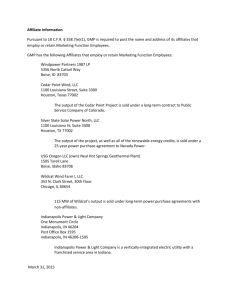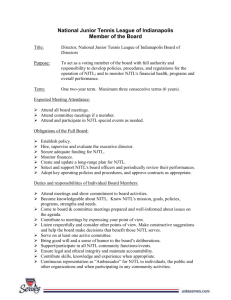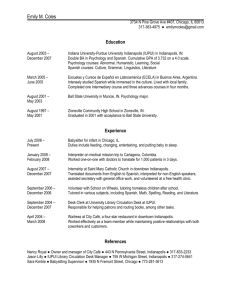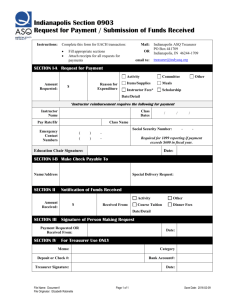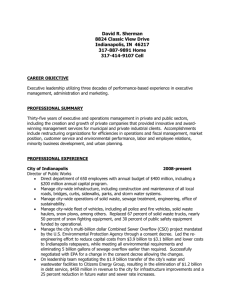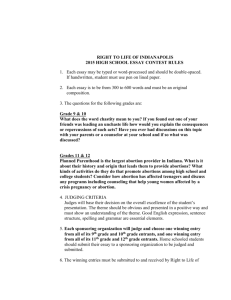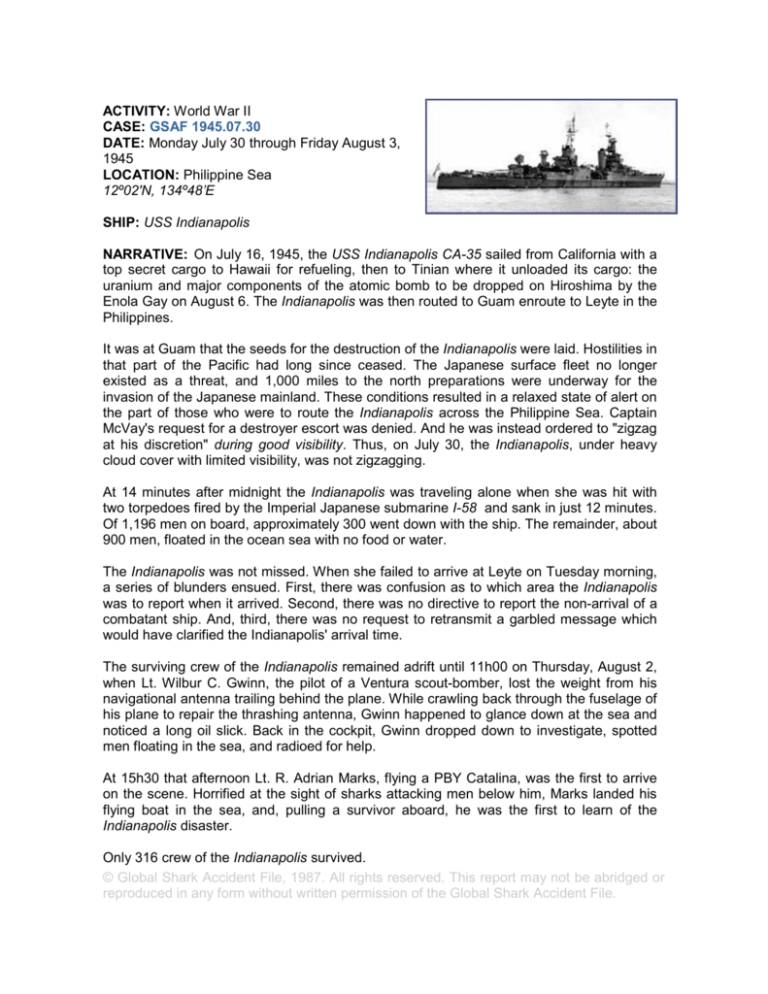
ACTIVITY: World War II
CASE: GSAF 1945.07.30
DATE: Monday July 30 through Friday August 3,
1945
LOCATION: Philippine Sea
12º02'N, 134º48’E
SHIP: USS Indianapolis
NARRATIVE: On July 16, 1945, the USS Indianapolis CA-35 sailed from California with a
top secret cargo to Hawaii for refueling, then to Tinian where it unloaded its cargo: the
uranium and major components of the atomic bomb to be dropped on Hiroshima by the
Enola Gay on August 6. The Indianapolis was then routed to Guam enroute to Leyte in the
Philippines.
It was at Guam that the seeds for the destruction of the Indianapolis were laid. Hostilities in
that part of the Pacific had long since ceased. The Japanese surface fleet no longer
existed as a threat, and 1,000 miles to the north preparations were underway for the
invasion of the Japanese mainland. These conditions resulted in a relaxed state of alert on
the part of those who were to route the Indianapolis across the Philippine Sea. Captain
McVay's request for a destroyer escort was denied. And he was instead ordered to "zigzag
at his discretion" during good visibility. Thus, on July 30, the Indianapolis, under heavy
cloud cover with limited visibility, was not zigzagging.
At 14 minutes after midnight the Indianapolis was traveling alone when she was hit with
two torpedoes fired by the Imperial Japanese submarine I-58 and sank in just 12 minutes.
Of 1,196 men on board, approximately 300 went down with the ship. The remainder, about
900 men, floated in the ocean sea with no food or water.
The Indianapolis was not missed. When she failed to arrive at Leyte on Tuesday morning,
a series of blunders ensued. First, there was confusion as to which area the Indianapolis
was to report when it arrived. Second, there was no directive to report the non-arrival of a
combatant ship. And, third, there was no request to retransmit a garbled message which
would have clarified the Indianapolis' arrival time.
The surviving crew of the Indianapolis remained adrift until 11h00 on Thursday, August 2,
when Lt. Wilbur C. Gwinn, the pilot of a Ventura scout-bomber, lost the weight from his
navigational antenna trailing behind the plane. While crawling back through the fuselage of
his plane to repair the thrashing antenna, Gwinn happened to glance down at the sea and
noticed a long oil slick. Back in the cockpit, Gwinn dropped down to investigate, spotted
men floating in the sea, and radioed for help.
At 15h30 that afternoon Lt. R. Adrian Marks, flying a PBY Catalina, was the first to arrive
on the scene. Horrified at the sight of sharks attacking men below him, Marks landed his
flying boat in the sea, and, pulling a survivor aboard, he was the first to learn of the
Indianapolis disaster.
Only 316 crew of the Indianapolis survived.
© Global Shark Accident File, 1987. All rights reserved. This report may not be abridged or
reproduced in any form without written permission of the Global Shark Accident File.
These are the men who located the
survivors of the USS Indianapolis. Front
row, l-r: Lt. Wilber C. (Chuck) Gwinn
Woody Eugene James - USS Indianapolis Survivor
Woody James, 20-years-old, was on his battle station inside the
first turret when the Indianapolis was torpedoed. He gave his
lifejacket to another survivor and spent the rest of the night in the
water clinging to a potato crate.
Tuesday-Day 1: “There was about 150 people in the group. We
were scattered around quite a bit. Well this isn't too bad, we
thought, we'll be picked up today.”
Wednesday-Day 2: “When the sharks showed up, in fact they
showed up the afternoon before but I don't know of anybody being
bit. . . The day wore on and the sharks were around. . .What a
long night.”
Woody Eugene James
Thursday-Day 3: “The sun finally did rise and it got warmed up again. Some of the guys
been drinkin salt water by now, and they were goin bezerk. . .The day wore on and the
sharks were around, hundreds of them. You'd hear guys scream, especially late in the
afternoon. Seemed like the sharks were the worst late in the afternoon than they were
during the day. Then they fed at night too. Everything would be quiet and then you'd hear
somebody scream and you knew a shark had got him.
Friday-Day 4: We're out there in the sun prayin for it to go down again, then low and
behold there's a plane. Course there had been planes everyday since day one. They
were real high and some of the floaters that had mirrors tried to attract them, but nothing.
Anyway, this one showed up and flew by. . Then we seen him turn and come back and
we knew we had been spotted. What a relief that was. . .Late in the afternoon before dark
there was another PBY on the scene. He dropped his survival gear and he dropped a
little three-man rubber raft. . .Now there's nine of us on this little raft. It's just about dark
and figure we'll make it through the night one way or another. About midnight, a little bit
before there was a light shining off of the bottom of the cloud and we knew then we were
saved. That was the spotlight of the Cecil Doyle. “
He was picked up by the Cecil J. Doyle on the morning of the 5th day and transferred to
a hospital ship.
SOURCE: http://www.ussindianapolis.org/woody.htm
Tommy Reid
“Our fighting ship was in ten major battles of the Pacific War; set a speed record from
San Francisco to Guam to deliver the atomic bombs which were dropped on Japan that
stands to this day. Our gun crew was unequaled, a proud ship at 14,000 tons with a crew
of 1200 officers and men. The majority of us booze- drinking, hell-for-leather rowdies
who cussed like sailors".
“SUDDENLY it was all gone: gun, guts, glory. In a matter of moments the tough guys
who were so vain, were either dead or shark food. 'WHAM-BOOM' in the middle of the
night. . . Roughly 800 of us made it into the life jackets to float and bob for five days and
nights - roasting in the day time, freezing at nights with no water or food. . . After 24
hours the wounded died - sharks were everywhere at once - men screaming, groaning,
with death all around us for five days and nights without rest. One estimate is that the
sharks killed about four an hour.
SOURCE: http://members.tripod.com/IndyMaru/indymaru8m.htm
The captain of the Indianapolis, Charles Butler McVay III, survived and
was court-martialed and convicted of "hazarding his ship by failing to
zigzag" despite overwhelming evidence that the Navy itself had placed
the ship in harm's way, despite testimony from the Japanese submarine
commander that zigzagging would have made no difference, and despite
that fact that, although over 350 navy ships were lost in combat in WWII,
McVay was the only captain to be court-martialed. Some years later, he
committed suicide.
Materials declassified in recent years proved that McVay was a scapegoat for the
mistakes of others. In October of 2000, following years of effort by the survivors and their
supporters, legislation was passed in Washington and signed by President Clinton
clearing Captain McVay's record. In July 2001 the Navy Department announced that
Captain McVay's record was amended to exonerate him for the loss of the Indianapolis
and the lives of those who perished as a result of her sinking.
The USS Bassett began the rescue just after midnight on August 3. Two LCVP landing crafts were
launched into the dark rough waters to retrieve the Indianapolis survivors. The rescue continued
throughout the night and into the dawn. Painting by Mark Churms
http://www.markchurms.com/jaws-sharks-attacks-u.s.s.-indianapolis-pictures-rescue-of-survivors-1945pacific-oceans.html
By Lauren Sonis, Staff Writer, Daytona Beach News-Journal, July 29, 2007
PALM COAST -- Marine Pfc. Giles McCoy floated in the Philippine Sea, kicking
sharks and sleeping in shifts, until rescue came for the survivors of the torpedoed
USS Indianapolis in the summer of 1945.
The Palm Coast resident's story will be among those featured by the Discovery
Channel starting at 9 p.m. today during the 20th anniversary of "Shark Week," a
week of television specials about sharks.
McCoy
Today's kickoff features the two-hour special "Ocean of Fear: Worst Shark Attack Ever," which
tells of the USS Indianapolis sinking, leaving more than 800 service members to fend off sharks,
starvation, thirst and constant saltwater and sun exposure."We don't know where the sharks all
came from, but boy were they there by the hundreds," McCoy said during an interview in May.
Many men perished but more than 300 were rescued, many of whom had floated in the water for
four or five days. About 1,200 were aboard the ship before the Japanese submarine I-58 sank it.
"Ocean of Fear," narrated by "Jaws" star Richard Dreyfuss, will look at why the sharks attacked
the way they did, why some did not attack, and the survival strategies of the men in the water,
including those who fought the sharks. Survivors will share their stories on camera. The show
reconstructs the struggle, filmed with real sharks, portraying the event from both the sharks' and
the humans' perspectives.
The Indianapolis carried the world's first operational atomic bomb to Tinian Island in the western
Pacific Ocean on July 26, 1945, according to Web site www.ussindianapolis.org. The Indianapolis
was supposed to join the battleship USS Idaho at Leyte Gulf in the Philippines to prepare for the
invasion of Japan, according to the site.
McCoy, a former Missouri doctor, retired to Palm Coast. McCoy said he spent five days in the sea
in 118-degree heat, and normally sips water when he tells the story. The 610-foot-long ship
capsized and sank within 12 minutes. McCoy remembers getting sucked down and then following
an air bubble to the surface. He said he felt the force of the ship's underwater explosion hit him in
the groin and the gut.
As they floated in the sea, two men armed with knives started fighting, cutting each other. "Of
course, when you start bleeding in the water, you attract more sharks," McCoy said during the May
interview. "We had to push them quickly out of our group, or there would be sharks all over us."
McCoy pointed his gun at the men -- though they did not know he couldn't fire it because it was
damaged. "I said, 'I want your knives,' and I said, 'If we're going to kill one another, we're going to
do it with our hands, we're not going to cut each other up,' " McCoy said. He threw the knives into
the water and threw his gun into the water.
By accident, a patrol plane pilot eventually spotted the men bobbing in lifejackets. The pilot called
for help.
McCoy, 82, could not be reached for comment this week. A neighbor said he is traveling, visiting
family and the USS Indianapolis survivor reunion. "It was easier to die than to stay alive," McCoy
said in May. "To stay alive, you had to work hard at it."
http://www.news-journalonline.com/NewsJournalOnline/News/Local/newFLAG01TV072907.htm
Ashes of USS Indianapolis survivor buried at sea
By Eric Talmadge
YOKOSUKA, Japan (AP) — When the submarine USS Ohio surfaced at sea and Machinist Mate
1st Class Jason Witty emerged from the hatch to look around, he saw calm, blue water under a
peaceful sky — perfect for the solemn task he was about to perform.
On the map, the Ohio was afloat in just another indistinguishable expanse of the Pacific Ocean.
As Witty stood on deck holding a silver pitcher, the vessel was alone.
Just like the ill-fated USS Indianapolis, 63 years earlier.
The pitcher contained the ashes of Witty's grandfather, Boatswain Mate 2nd Class Eugene
Morgan, who had survived the sinking of the Indianapolis — one of the worst tragedies for the
U.S. Navy in World War II.
Morgan had died of a heart attack in June at age 87, just before Witty went to sea, and among his
last wishes was the desire to be rejoined with his shipmates at roughly the same spot in the
Pacific where the Indianapolis went down.
Witty, sitting in a wardroom of the Ohio at this Japanese port, recounted the Oct. 2 burial at sea,
saying he had never participated in one before.
He had sheepishly asked one of the officers if his grandfather's wish could be granted. The
request went up the chain of command to Capt. Dennis Carpenter, who quickly approved.
"I thought it would be an honor," Carpenter said. "And I wanted to make sure that we did it right.
Sometimes on a submarine at sea, you just can't go topside. But everything seemed to be on our
side."
___
In July 1945, the Indianapolis had just completed a secret mission to the tiny island of Tinian,
carrying components for a new weapon — the atomic bomb. It would later be dropped on
Hiroshima, Japan, in the world's first nuclear attack.
Because of its cargo, the Indianapolis had sailed to Tinian unescorted. Now, with that mission
done, the cruiser was making its way back to Leyte, in the Philippines, with a crew of 1,196
aboard, including Eugene Morgan. Early on July 30, when the ship was still near the Marianas
Islands, a Japanese I-58 submarine found the Indianapolis and launched six torpedoes, two
ripping through its starboard side.
It took only 12 minutes for the Indianapolis to sink in the deadliest disaster at sea in U.S. naval
history.
Morgan was asleep when the ship exploded into chaos.
"He was in his skivvies," Witty said. "He was tossed from his rack. There were fires. He got
topside and the boat started to capsize."
Morgan jumped off the port side of the ship and slid down into the black sea.
"At some point, he found some food floating on the surface and swam toward it," Witty said. "But
on the way, he was attacked by a shark."
It swam away before going in for the kill. For the rest of his life, Morgan carried scars on his
backside from the attack.
Many of his shipmates weren't so fortunate. Morgan could hear their screams as they were
attacked.
By the time help arrived five days later, 879 sailors were dead — from drowning, sharks,
dehydration, or from injuries suffered in the attack itself. Morgan was one of only 317 to survive,
floating on makeshift rafts, wreckage or clinging to each other.
The tragedy inspired the famous monologue in the movie "Jaws," in which the seasoned shark
hunter played by Robert Shaw tells of the horrors of floating in the shark-infested waters while
awaiting rescue.
Morgan was eventually saved when Navy seaplanes landed in the water and started to pluck out
survivors. Some were hallucinating — they thought they were under attack by the Japanese again
— and others were hysterical. Ships also arrived to assist in the rescue.
Only one more U.S. ship would be sunk before Japan's surrender in August 1945.
The Indianapolis itself has never been found.
___
Morgan, a Seattle firefighter after the war, kept the experience to himself for more than four
decades.
Witty, of Puyallup, Wash., joined the Navy right out of high school. Two years later, his grandfather
opened up.
"I knew that he was in the war, in the Navy, but he never really talked about it until after my
grandmother died," Witty said. "One day I just got up the courage and he told me the story."
Once the door was open, Morgan began talking about the tragedy every chance he got. He was a
frequent visitor at local schools and historical groups and took part in documentaries to make sure
that the story of the Indianapolis would not be forgotten.
"I was worried that he would have bad feelings for me, being a submariner," Witty said. "It was a
sub that sank his ship. But he never held that against me."
Morgan's burial at sea, on Oct. 2, was simple but somber.
Scripture was read, along with a eulogy written by another of Morgan's grandsons, Steven Wilson.
The order was given for the firing detail to ready their rifles, and three shots rang out.
Turning to face the sea, Witty held the silver pitcher wrapped in a blue cloth over the side of the
deck and spread the ashes to the wind.
"Just going to that spot on the chart, what went through my mind was what they must have gone
through," Witty recalled. "They knew they were by themselves."
SOURCE: Associated Press, October 30, 2008,
http://ap.google.com/article/ALeqM5hlxB5rtCjTDG9CgCT8qCKSi5sfCQD945KCC80

